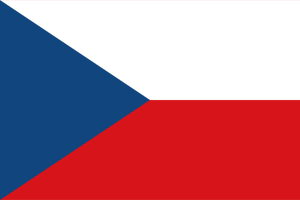
| Colors | HEX Code | RGB | CMYK |
|---|---|---|---|
| Blue | #11457E | 17, 69, 126 | 87, 45, 0, 51 |
| White | #FFFFFF | 255, 255, 255 | 0, 0, 0, 0 |
| Red | #D7141A | 215, 20, 26 | 0, 91, 88, 16 |
The Czech Republic flag has a blue triangle at the hoist, and two equal horizontal stripes, white on the upper side, and red on the lower side.
Meaning of the Czech Republic Flag
The colors of the Czech flag are borrowed from the coat of arms in Bohemia in the 12th century, which featured a white lion on a red shield. The three colors were first used to represent Czechs, Slovaks, and Ruthenians. The white color represents the traditional color of Bohemia and represents the sky. The red color represents the bloodshed for the freedom of the state. Blue is the traditional color of Slovakia, but as Slovakia separated from the Czech Republic, it is now symbolic of impartiality and sovereignty.
History of the Czech Republic flag
The Czech Republic was named Bohemia. It was a very powerful Kingdom that was part of the Roman Empire. Since the twelfth century, it had its coat of arms that pictured a white, crowned lion with double tails on a red shield. Later, it joined the Austria-Hungary Kingdom, and there was no need for a flag. At the end of WWI, the Czechs, Slovaks, and Ruthenians united to form a new country named Czechoslovakia. The flag adopted was simply white and red. The flag did not receive approval because it only represented the Czechs and resembled the Polish flag. The flag was changed in 1920 to incorporate a blue triangle. The colors of the new flag represented the different parts of the country. The flag was not used during WWII. Then Czechoslovakia was under communist rule, but the flag did not change. In 1993, the Slovaks separated to establish their own country Slovakia, so the remaining parts of the country were named the Czech Republic. While Slovakia designed its own flag, the 1920 flag became the official flag of the Czech Republic.